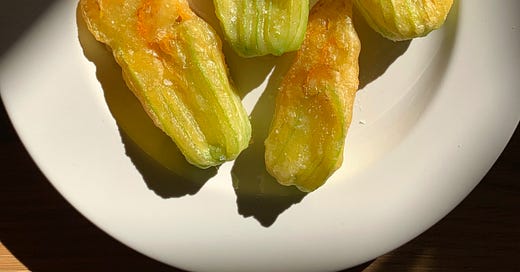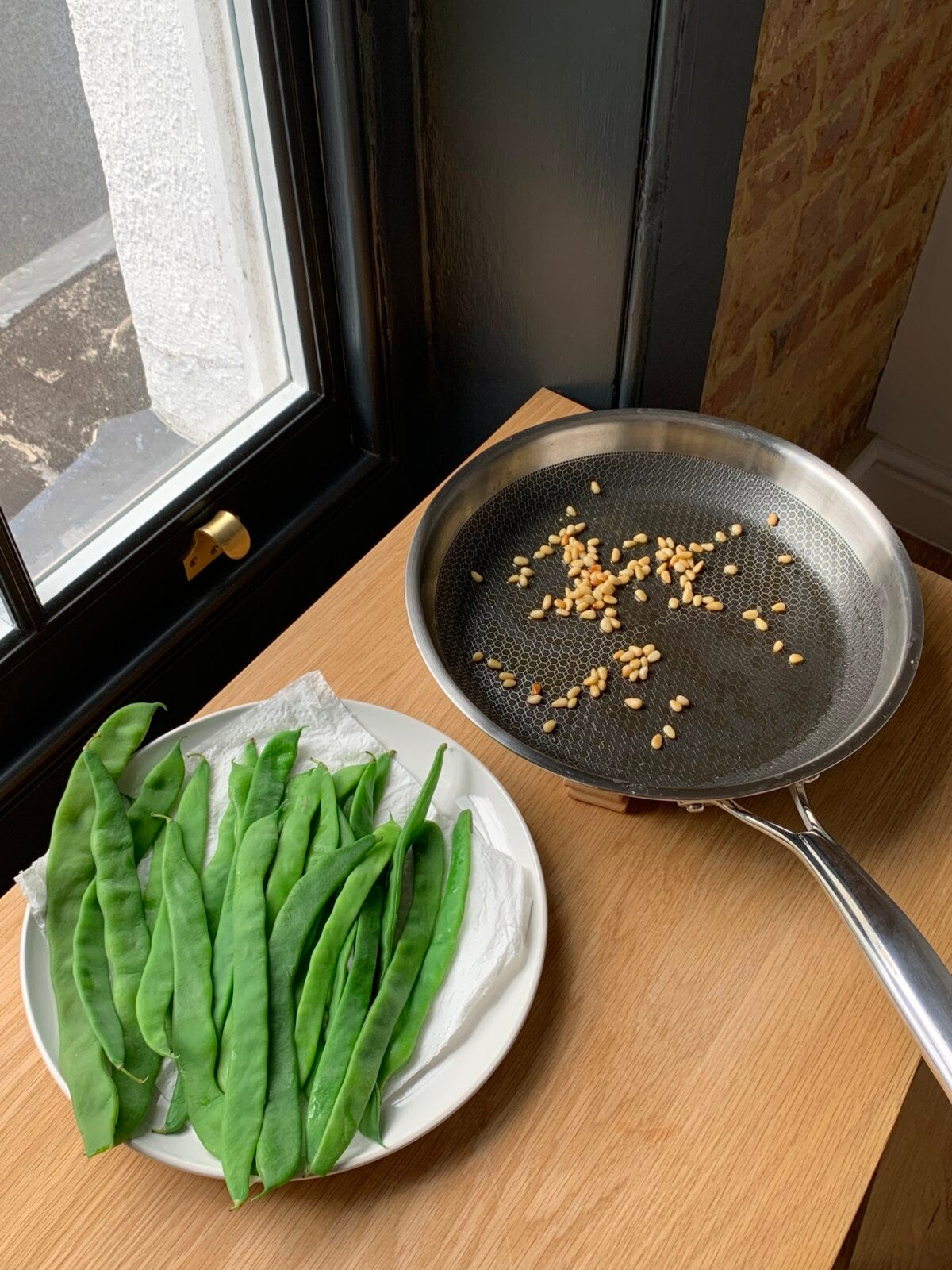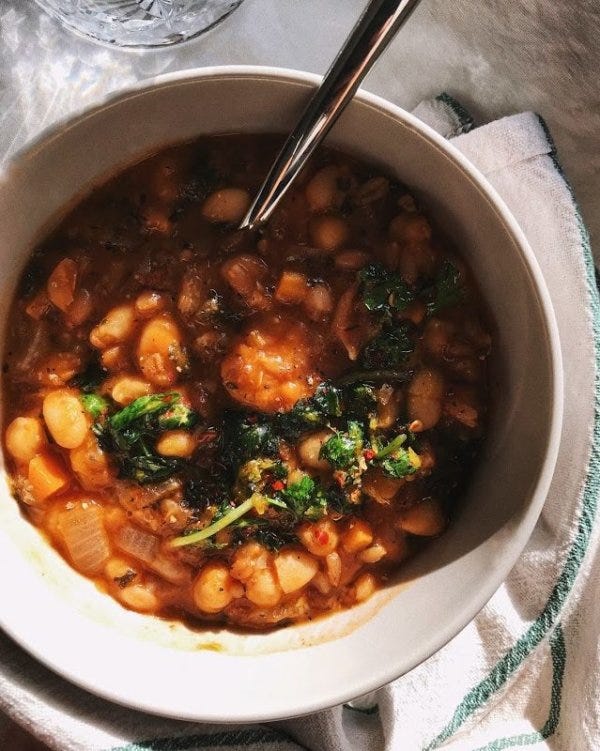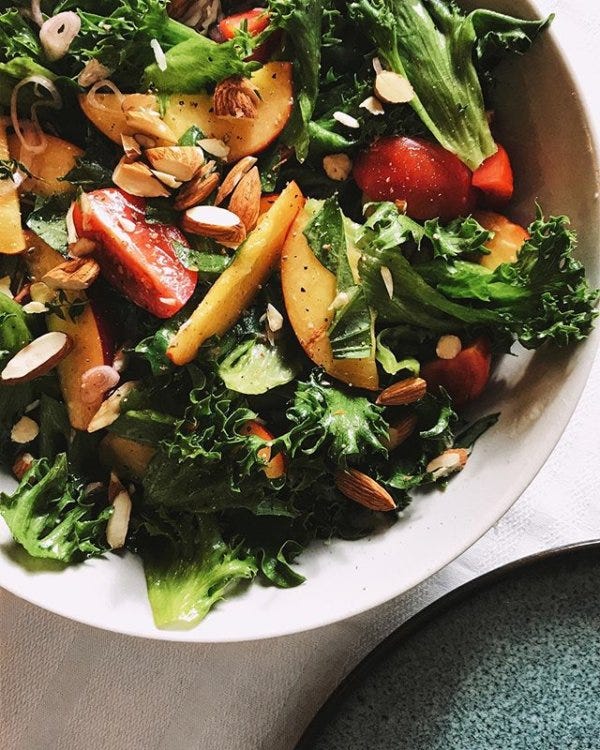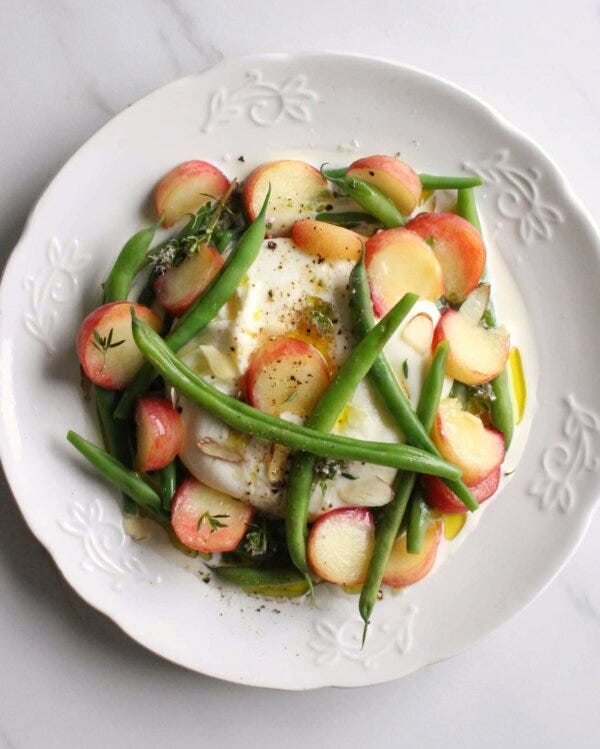Creamy Beds for Samphire & Apricots, Romano Beans, and Zucchini Blossoms
sunny rays and recipe-free days + the pleasures of a slow summer
Allô! 👋
I hope you're doing well. What a month's July's been! So many things to see and do, all while faced with the reluctant awareness that, all too soon, the season shall pass (as it is invariably known to do) before one has truly had a chance to see and do all the things one wanted to see and do.
London's weather hasn't exactly been very summery lately, and yet, the sun's rays continue to shine brightly at farmers' markets across the city in the form of vibrant produce. It's the sort of food so fresh, so enticing, that you hardly want to do anything to it at all. Punnets of berries and cherries start to dwindle the moment they reach eager hands, tomatoes get popped straight into open mouths, and herbs are inhaled over and over, as though a bouquet of fragrant flowers, as folks merrily make their way home laden with their radiant loot from the community growers who feed us well.
Aside from ingredients that absolutely require transformation through heat, July is a month where there truly is no great desire to prepare anything particularly elaborate or fussy. Especially the first few times you eat a particular fruit or vegetable. It is only once the novelty has worn off that one seeks to do something a little more interesting with one's produce and often, by then, there are new and exciting ingredients available to try and distract you from the task.
The combination of long, rainy, overcast days and little time spent in the kitchen means more time to catch up with friends, explore the countryside, go to museums and/or theatres, read through that stack of books that's been accumulating for the last six months by the side of the bed, or simply savour the dog days of summer. It's quite enjoyable, in a way, and since there's not much one can do about it, I think slowing down to embrace a somewhat sun-less season of sun has been rather nice, indeed.*
In this newsletter you'll find a few new recipes (I use the term "recipe" loosely here, as precision is not required for any of them) as well as old favourites, some tidbits from the news, and a brief overview of what's in season at the moment — even though it may feel, at this time of year and in this hemisphere, like that might as well be everything, you'll certainly want to be focusing on some types of produce more than others. So, sit back, relax, read and enjoy! Much like a local greengrocer's shop, there's lots to choose from. I hope you'll find something you like.
Wishing you a lovely harvest month, lots of seasonally appropriate weather, and a great end to your mid-summer,
👋simone
*If, however, you've been suffering the effects of climate change this summer, I do hope you and your loved ones have managed to cope well. Extreme weather events are no joke.
samphire & apricots, with creamy burrata, basil and lemon 🍑
The other day I went into a shop looking for yellow wax beans (for whatever reason, I prefer them to green beans — despite the two being essentially the same vegetable) and, instead, came out with samphire.
Until this last month, I'd only ever heard of samphire, never seen it in a store or eaten it (let alone cook it), so I was thrilled when I noticed it on the shelf and almost instinctively reached for it, eagerly plopping it into my basket without thought or hesitation. If you ask me, cooking and eating new-to-you ingredients is one of the great joys in life. It forces you to rediscover your skills and get reacquainted with your senses — indeed, every time I am challenged with preparing a newfound ingredient, I feel like I've forgotten how to cook and am only just being introduced to the concepts of sight, smell and taste. It's thrilling and I love it and I hope to never let it stop happening.
All that said, I brought the samphire home, scratched my head about what to do with it, then let myself be inspired by what I already had in the kitchen. Foods with overlapping harvest seasons tend to pair well (in fact, there is even a fabulous saying that goes "what grows together, goes together"! think of basil and tomatoes, beans and corn, potatoes and garlic! not to mention blood oranges and radicchio, radishes and asparagus, chestnuts and quince), and the combination of apricot, basil and samphire turned out to be a beautiful introduction to the sea vegetable indeed. Whether this ingredient is new to you or not, I do hope you'll try this out and, hopefully, enjoy it as much as I did.
•••
SAMPHIRE + APRICOTS WITH BURRATA, BASIL & LEMON
serves 2 to 4, depending on appetites and accompanying dishes
INGREDIENTS
• 3 ripe apricots
• roughly 60g samphire*
• 1 large ball burrata (around 125g)
• fresh basil leaves
• ~1 Tbsp freshly squeezed lemon juice
• freshly cracked black pepper
• extra virgin olive oil
• optional: a small handful of toasted flaked almonds
*note: when making this, I cooked 90g of samphire but only ended up using around 2 thirds of it when it came time to plating, so go with your gut in terms of how much to serve!
METHOD
1. Remove any stems from the apricots, then slice each in half vertically using the fruit's groove as a guide. Remove the pits, then cut some (but not all) apricot halves into rough quarters.
2. Add a small splash of olive oil into a large frying pan on medium-high heat, then add the apricot quarters and halves to the plan, flesh-side down. Cook until the flesh has softened and caught a bit of colour, then flip and cook a minute or two longer on the skin side. Once cooked, remove the apricots from the pan and set aside on a plate.
3. Rinse the samphire well in cold water, snapping off any tough stems if necessary. Samphire is quite salty on its own, so the longer you rinse or soak it, the more salt will be washed away. Using the same frying pan as for the apricots, either blanch (in unsalted water) or sauté the rinsed samphire for around 3 minutes, until vibrant green and tender but still snappy.
4. On a large serving plate or on smaller individual plates, spread out a layer of burrata. Place apricot pieces over top, then finish with a layer of samphire. Squeeze over a bit of fresh lemon juice, then tear the fresh basil leaves over top. To finish, season with freshly cracked black pepper (no need for salt here!) and drizzle on a bit more olive oil. For a bit more balance and added crunch, you may also want to scatter some toasted flaked almonds over top.
it's mid-summer
what to cook?
🍑🍯🥒
The nice thing about fresh produce being so abundant all throughout summer is that there really isn't much cooking required to churn out a fantastic meal. Most of the time, all you have to do is dress an ingredient that's barely been cooked (if at all) in a medley of herbs, oils and vinegars — perhaps with a sprinkling of seeds, a mincing of alliums and/or a zesting of citrus if you're feeling industrious — and you're good to go.
Be that as it may, below are some ideas for cooking slightly more elaborate (yet still very simple) meals to celebrate and make the most of mid-to-end-of-summer produce.
•••
tomatoes 🍅 excellent in sandwiches and salads, you'll want to salt these generously to bring out maximum flavour. have extra time on your hands? roast them slow or chop them up raw and make them the star of your next risotto. pair well with: corn, basil, peaches, fresh cheeses, whole grains.
fresh herbs 🌿 dried herbs are a universal pantry staple for good reason, but fresh herbs offer a whole world of flavour unto themselves and should be taken advantage of across their harvest season — from first leaf to last blossom. even as a garnish, they elevate any dish, and in these times where they are so abundant, it would be a real shame not to make them the star of a dish. herb omelettes, salads, and fritters are all good ways of making the most of these aromatic marvels. pair well with: everything!
sea vegetables 🌊 an often forgotten category of veg, though it certainly doesn't have to be — if you think norimaki is lovely year-round and that furikake is a must-have condiment in your house, you may already be making the most samphire season all while dreaming up your next sea purslane dinner. if not, seek these delightful sea vegetables out and give them a shot! you might just find that you love them. pair well with: mint, fresh cheeses, cucumber, seafood, lemon.
peppers 🌶️ although peppers are delightfully light and crunchy when enjoyed raw, their potential seems to be unlocked when processed in some way: pickled, dried, infused into oil, cooked down slowly or charred quickly until soft and sweet — the possibilities are as varied as they are delicious. pair well with: corn, olives, onions, creamy cheeses, roasted meats.
gooseberries, currants and physalis 🍓sure, strawberries, raspberries, blueberries and blackberries are perfect for topping your morning yogurt/muesli/porridge (and an obvious snack for a countryside drive or saturday picnic), but so are all sorts of other berries! these all bake beautifully into crumbles or cakes, and are a natural accompaniment to charcuterie boards and cheese platters. pair well with: almonds, woody herbs, cured meats, strong cheeses, dairy desserts.
stone fruit 🍑 similar to the fruit above, these are fantastic enjoyed as is. consider slow-roasting, poaching, barbecuing, or adding raw to salads. from cherries to pluots and nectarines to greengages, each comes in a wide variety of colours, shapes and sizes, so try to find and enjoy as many as you can. pair well with: tender herbs, olive oil, grilled meats, fresh cheeses, tomatoes, whipped creams, ice creams, and custards.
summer squash 🥒 while dark green zucchini is what usually comes to mind (and is most easy to find) when it comes to summer squash, one mustn't forget others like pattypan squash, yellow squash, and round varieties. wonderfully delicate when thinly sliced and raw, these are also fantastic grilled, stuffed, confited, marinated or baked into a cake. don't forget the edible flowers! pair well with: garlic, pine nuts, corn, tomatoes, peppers, chocolate.
eggplant 🍆 a fantastically low-maintenance ingredient in the kitchen, eggplant packs a punch no matter how you prepare it: creamy and soft as a dip, hearty and flavoursome when breaded and fried schnitzel-style, and deeply savoury when stewed into a caponata, ratatouille or cheesy gratin. pairs well with: tomato sauce, peppers, soy sauce, chickpeas, pasta.
romano beans & toasted pine nuts
with a thick yogurt + hummus spread
🍽️
This one is a fun way to use a favourite dip in a way other than just a condiment for bread or crudités. Here, I use a mix of hummus and greek yogurt, but you could also go for a white bean dip, an herby labneh, or some caramelised onions blitzed with roast cauliflower into a thick base. As always, focus on quality, and follow your tastes and the season!
•••
ROMANO BEANS & TOASTED PINE NUTS WITH A THICK HUMMUS + YOGURT DIP
serves 2-4, but feel free to adjust to make as much as you like!
INGREDIENTS
• a good handful of pine nuts
• optional: a good handful of toasted flaked almonds
• optional: a pinch or two of sesame seeds
• approx. 250g romano beans* though any long green bean variety should work just fine
• approx. 185g hummus* if using store-bought, seek out a hummus that contains mostly or only "home" ingredients and little to no additives, if possible; I find these (as well as ones that use extra virgin olive as their only oil) tend to taste best, but they are also the hardest to come by!
• approx. 100ml greek yoghurt* nice and thick!
• fresh mint leaves
• a pinch of chili flakes
• sea salt
• extra virgin olive oil
*these are approximate measurements because they don't need to be exact and will depend on how many people you'd like to serve, but it's always useful to give a rough idea!
METHOD
1. Add a small splash (1-2 Tbsp or so) olive oil to a large frying pan. Add in a handful of pine nuts and, if using, a handful of flaked almonds and a good pinch or two of sesame seeds, and toast on medium-high heat, stirring regularly, until golden. It will feel at first like nothing is happening, but nuts and seeds can be quick to burn, so keep an eye on them and don't walk away. Transfer to a small plate or bowl once golden and fragrant.
2. Using the same frying pan (no need to wash it), blanch around 250g beans in a shallow amount of salted water. To do this, bring 3-4cm of water to a strong simmer, season with salt, add the beans, then leave to cook for a few minutes until the beans are bright green and you can easily pierce one with a fork, without being so soft that the bean slips right off the fork again. Drain, then rinse under cold water until cool. Pat dry with a clean dishtowel or paper towel (AKA kitchen roll 🇬🇧), and set aside.
3. In a separate bowl, combine approx. 185g hummus and 100ml greek yoghurt. Season with a small pinch of salt and stir well. You may want to jazz this up with fresh lemon zest or confit garlic, but keeping things simple yields a great result just as well.
4. To serve, spoon out the yoghurt hummus dip onto one large serving plate, or 2-4 smaller individual plates. Top with the blanched beans, then scatter over the toasted pine nuts (and flaked almonds + sesame seeds, if using). Finely chop up a handful of fresh mint leaves and let those tumble over the beans, along with some chili flakes and flaky sea salt. Drizzle over some extra virgin olive oil to finish, and enjoy!
recipes from the site
+ some ideas from instagram
✨
white bean, chickpea & spelt stew
As much as I love beans and other legumes, I regularly struggle with figuring out what to do with them. Often, what ends up happening is that I’ll soak some…
charred fairy tale eggplant
This eggplant variety is small and minimally-seeded, making it the perfect candidate for a low-effort, high-reward dish. Scorch quickly on high heat and serve with cool swoop of garlicky yogurt.
bright & green nectarine salad
Got some nice produce and don't feel like cooking, but still want to prepare something exciting and refreshing? Make this nectarine salad.
slow-cooked peppers & spiced rice
Sweet, smoky, savoury — need I say more? This piperade-ish dish is deceptively simple to make, and only gets better with time spent in the fridge.
peachy green bean burrata plate
On those warm days when you just don't want to cook, assembling a plate with peach, burrata and green beans always seems to hit the spot.
shallow-fried zucchini blossoms
with savoury whipped herb cream
🌼
The first time I got my hands on zucchini blossoms, I instantly knew I wanted to try my hand at making the battered classic. I also knew that there was no way I'd be deep-frying them. What a hassle.
Lucky for me (and for you), it turns out you that don't need to. I happily shallow-fried my battered flowers in just enough olive oil to barely cover the bottom of a pan, and it ended up working perfectly — now I've been making fried zucchini blossoms this way ever since.
This summer, inspired by a spring recipe for white asparagus I read in a David Tanis book, I decided to try them with a savoury whipped cream. What a revelation!
•••
SHALLOW-FRIED ZUCCHINI BLOSSOMS WITH SAVOURY WHIPPED CREAM
makes enough to serve 2, 3 or 4 — depending on appetites and the number of accompanying dishes
INGREDIENTS
• 8 medium-sized zucchini blossoms (AKA courgette flowers)
• roughly 60g self-raising flour* if using 60g plain flour instead, add around 2g baking powder
• roughly 100ml sparkling water*
• 150ml double cream you can also use whipping cream, so long as it's at least 35% fat
• a pinch of chili flakes
• ~8 medium fresh mint leaves
• ~4 large fresh basil leaves
• the zest of half a lemon
• sea salt
• freshly cracked black pepper
• extra virgin olive oil
*these are rough measurements because they don't need to be exact (you'll have extra batter left over anyway)! just keep tweaking until you reach a thick liquid consistency, loose enough to coat the back of a spoon, not unlike pancake batter

METHOD
1. Delicately open each zucchini blossom using three fingers. Reach to the bottom, then remove the pistils and stamens by pinching them out. Pull off any spiky green sepals (see two photos above) from the outer base of the flowers as well before setting the prepped flowers aside.
2. In a large bowl, whisk together self-raising flour and sparkling water until a thick, smooth batter forms (see note with ingredient list above). Season with a good pinch of salt and whisk again to combine.
3. In a separate bowl, whip the cream until it just holds its shape (keeping the cream and bowl as cold as possible will help with this step!). Keep the cream in the fridge while you fry the flowers.
4. Preheat a pan on medium/medium-high heat, then sparingly coat its bottom with olive oil. Deposit a drop of batter in the pan to check the temperature — if nothing happens, the oil is not hot enough yet, and if things splatter and quickly burn, the heat is too high. You want a soft sizzle as the batter touches the oil.
5. Bring the flowers and the batter close to the heated pan. One by one, dip each prepped zucchini blossom carefully into the batter, making sure it is well-covered all over before transferring it to the hot oil. Note that you don't want to crowd the pan, so you may have to do this in two batches. Cook each blossom until golden and crisp on each side, then transfer to a plate lined with a clean dish towel (this'll help remove any excess oil). If at any point during cooking the bottom of the pan starts to get dry, simply add in a little more olive oil.
6. While the last flowers finish cooking, remove the whipped cream from the fridge. Stack the mint and basil leaves on top of each other, then roll them up into a little scroll. Slice them across their width into fine strips (this technique is called chiffonade). Add them to the bowl with the cream along with a pinch of chili flakes, as large or small as you'd like depending on your spice tolerance, then season with salt and pepper before gently stirring the herbs and spices evenly through. Note that the cream will continue to thicken as you stir, so you'll want to be mindful of not overdoing it.
7. To serve, spread the whipped savoury cream onto one large communal or 2-4 small plates, dividing the number of flowers across plates, and stack the battered flowers on top of the herby cream. Season one last time with flaky sea salt, and let people immediately dig in by scooping up the cream with the fried blossoms.
last... but not least:
the public health corner
a few parting links, as food for thought
📺 ONE VIDEO
Ultra-Processed Food: A Recipe for Ill Health? (BBC Panorama)
link to associated article for those who can't access the episode
🗒️ ONE ARTICLE
How the long shadow of drink giants pushes public health and sugar labelling into the shade (ABC 🇦🇺 News )
🎧 ONE PODCAST EPISODE
Feeding your brain: A User's Guide (The Food Programme)
📘 ONE BOOK
Hooked, Michael Moss (McLelland & Stuart)
P.S. I always have a hard time just picking one of each so, in case you're interested, there's plenty more where that came from!
That's all from me this month!
See you next time 💛
This was a Substack edit of an archived newsletter. To read the newsletter in its original format, click here.


